This series is focused on the "Holy Grail" for most REIT investors: identifying stocks in a strong sector with a huge dividend yield that are also positioned for profitable growth.
Part 2 will take a closer look at three of the contenders: The $263 million cap Independence Realty Trust Inc IRT yielding about 7 percent; its external manager, the $660 million cap RAIT Financial Trust RAS, which yields nearly 9 percent; and the $71 million micro-cap Bluerock Residential Growth REIT Inc BRG.
Bluerock recently announced a monthly dividend of $0.96 per share and is currently yielding about 9 percent on an annual basis.
Sector performance at a glance
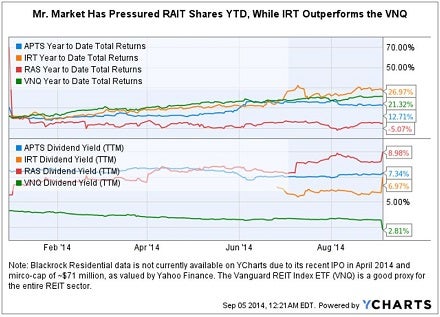
RAIT Financial Trust has a four-pronged business focus: real estate lending, real estate ownership, property management and asset management. Oftentimes, this diversification makes it difficult for analysts to model future performance.
In the second quarter, RAIT's key takeaways included: An increase of total assets under management to $5.3 billion, $246.3 million worth of loan origination (consisting of $112.8 million bridge loans, $119.7 million conduit loans and $13.8 million mezzanine loans), and a dividend of $0.18 per share. The latter represented a 38 percent increase year-over-year.
Worth noting, the dividend represents a reasonable 75 percent of CAD, or cash available for distribution, of $0.24 per share. Non-cash mark-to-market losses stemming from "RAIT's legacy Taberna portfolios and the associated hedges," were excluded from CAD calculations.
RAIT reported a net-loss for the three-month period ended June 30, 2014 of $25.7 million, or $0.31 per diluted share, compared to a net-loss of $0.94 per diluted share outstanding for the three-month period ended June 30, 2013.
Concerns regarding these reported non-cash mark-to-market losses may have been a contributing factor to RAIT's poor stock performance in 2014.
A Note On Independence Realty
Often, when a new REIT is starting out, external management can actually be the most cost effective alternative. However, it is also true that it can be a "red flag" for investors, who must decide if the fees and incentive compensation are reasonably aligned with shareholder interests.
In this case, shareholder interests appear to be aligned. External manager RAIT is the largest Independence Realty shareholder, holding 28 percent of the company's common shares outstanding as of July 30, 2014.
While the Independence Realty apartment community business model benefits from current downward trends in home ownership, common shareholders are essentially placing a bet with "the house" -- owning shares alongside the RAIT Financial Trust management team.
RAIT Financial Trust's Real Estate Operations
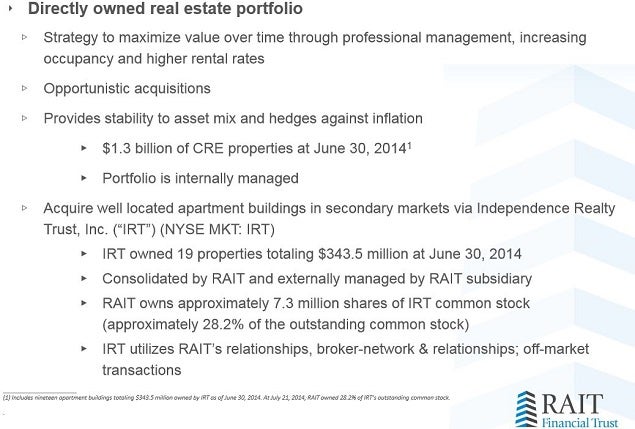
In contrast to some multi-family REITs -- involved with the development and construction process of new apartment communities -- the Independence Realty model is much simpler to understand.
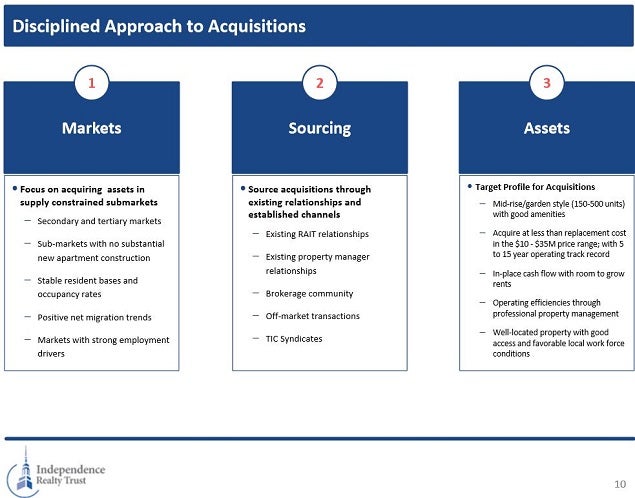
Independence Realty's Advantages
Some of the key facets of the Independence Realty approach to accretive growth include: leveraging RAIT's industry knowledge of off-market transactions to bolster acquisition cap rates (currently targeting opportunities in the 6.25 percent to 7 percent range), and the acquisition of existing seasoned communities at less than replacement cost, which gives Independence Realty communities a competitive leasing advantage.
RAIT Residential is a property manager of 12,000 units, which allows Independence Realty to take advantage of best practices and software platforms to optimize net operating income. The company also utilizes RAIT's in-house commercial lending arm for better access to low-cost debt to lock-in the spread, and increase returns on invested capital.
A recent permanent financing example cited by RAIT/Independence Realty CEO Scott Schaeffer during its June 3, 2014 REIT Week Investor Forum presentation, was the ability to obtain 3.88 percent, 10-year term, interest only loan for The Crossings at Ridgewood community located in Jackson, Mississippi.
On August 4, 2014, Wunderlich Securities reiterated a Buy rating on Independence Realty and raised its price target from $9.75 to $10.75.
What About Bluerock Residential?
On April 2, 2014, Bluerock completed its IPO, raising $50 million from the sale of close to 3.4 million shares at $14.50 per share. At close of trading on Sept. 4, 2014 Bluerock Class-A common shares hit 13.92 per share, which equates to a market cap of about $77 million.
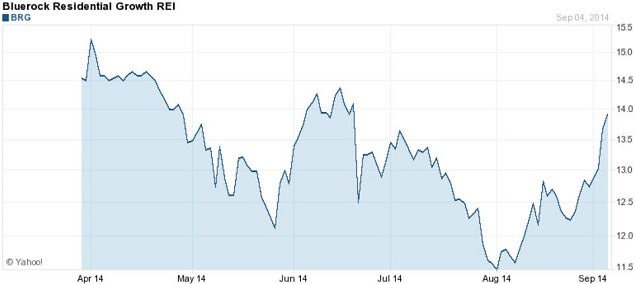
After the close of the market on Sept. 3, 2014 a bullish Seeking Alpha PRO article became available to the general public.
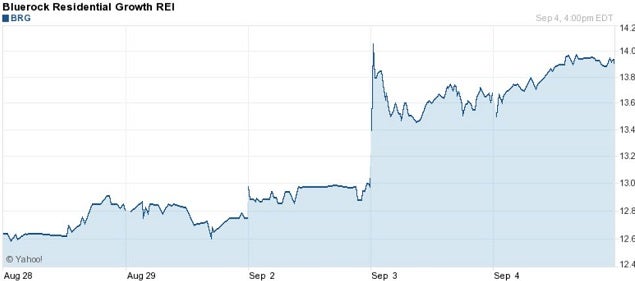
By the end of the next trading day, Bluerock had already jumped on the news.
This is one of the characteristics of a lightly traded micro-cap stock: a propensity to rise or fall on either news or rumors.
Bluerock Pros and Cons
In the REIT space, one of the not-so-secret ingredients for success is the ability to manage the spread between acquisition cap rates and the weighted average cost of capital. Conversely, a primary disadvantage of small REITs is the lack of an investment grade rating, which can make it difficult to access the capital markets at competitive rates.
Bluerock appears to be off to a great start in that regard.
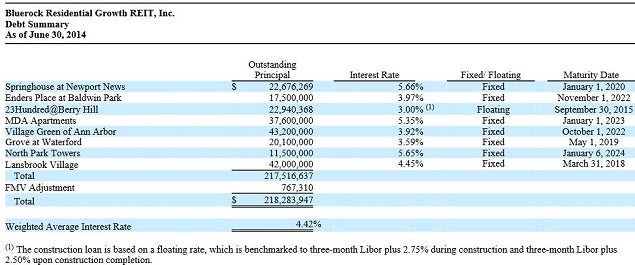
As luck would have it, the timing of its IPO coincided with a declining interest rate environment, most notably in 10-Year Treasury Notes. Bluerock management has done a great job of locking in low fixed rate mortgages for its nine-property portfolio.
A partial interest in all but one of its existing properties also appears to give Bluerock a built-in acquisition pipeline.
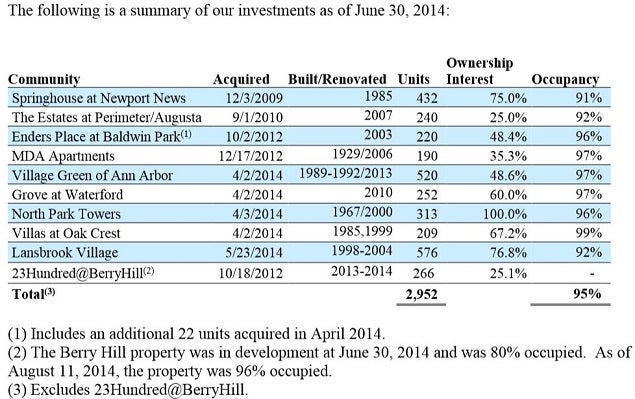
In other words, Bluerock has not randomly acquired mom and pop apartment communities. Its partners own and manage over 170,000 apartment units.
Additionally, when Bluerock announced earnings for the quarter ended June 30, 2014, it also revealed that it had made preferred equity investments in two development projects during July 2014: a 340-unit, Class-A development in Houston, and a 296-unit Class-A development project in Orlando, FL near the University of Central Florida. These investments were structured to provide Bluerock with a 15% current return on its investment.
In addition to the generic risks associated with being a new, small-cap issue, there are a few risks that are specific to Bluerock Residential Growth REIT. In no specific order, they include: A lack of diversification inherent in its small portfolio size, the fact that Bluerock is externally managed and development risks that are exacerbated by its small size.
Moreover, a large number of Class-B shares, which convert to Class-A shares over the next year-and-a-half may dampen stock appreciation.
The Big Picture
For Bluerock, it is way too early in the game for many REIT metrics to be used for evaluation purposes. However, it does appear management is executing a cogent growth plan, while taking advantage of historically low long-term interest rates.
That, along with the company's dividend, makes this growing micro-cap an intriguing idea for investors.
Disclosure: At the time of this writing, Bill Stoller had no position in the equities mentioned in this report.
© 2025 Benzinga.com. Benzinga does not provide investment advice. All rights reserved.
Trade confidently with insights and alerts from analyst ratings, free reports and breaking news that affects the stocks you care about.